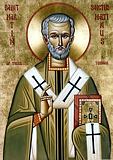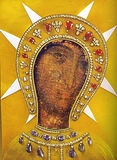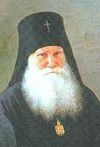

| Previous day | Next day |
| Old Style
October 12
|
Friday |
New Style
October 25
|
|
18th Week after Pentecost.
Tone 8.
Fast Day. |
Wine and oil allowed.
|
![]() Martyrs Probus, Tarachus, and Andronicus, at Tarsus in Cilicia (304).
Martyrs Probus, Tarachus, and Andronicus, at Tarsus in Cilicia (304). ![]() St. Cosmas the Hymnographer, bishop of Maiuma (ca. 787).
St. Cosmas the Hymnographer, bishop of Maiuma (ca. 787).
Martyr Domnina of Anazarbus (286). St. Martin the Merciful, bishop of Tours (397). Sts. Amphilochius (1452), Macarius (1480), and Tarasius (1440), abbots, and Theodosius, monk (15th c.), of Glushitsa Monastery (Vologda), disciples of St. Dionysius of Glushitsa. Uncovering of the relics of St. Macarius of Zheltovodsk and Unzha (1671). Translation from Malta to Gatchina: of a Particle of the Life Giving Cross, the Filersk Icon of the Mother of God, and the relic of the Right Hand of John the Baptist (1799). St. Arsenius, archimandrite, of Svyatogorsk Monastery (1859). St. Euphrosyne (Mezenova) the Faster, schema-abbess, of Siberia (1918). Glorification of St. Philaret, archbishop of Chernigov (2009).
New Hieromartyr Lawrence (Levchenko), hieromonk, of Optina Monastery (1937). New Hiero-confessor Nicholas (Mogilevsky), metropolitan of Alma-Ata (1955).
“Jerusalem” (48) and “Kaluga” (1748) Icons of the Most Holy Theotokos.
Hieromartyr Maximilian, bishop of Noricum (284). St. Mobhi of Glasnevin (Ireland) (544). Martyr Edwin, king of Northumbria (633). St. Wilfrid, bishop of York (709). Translation of the relics of St. Sabbas the Sanctified from Rome to Jerusalem (1965). Virgin-martyr Anastasia of Rome (ca. 250). St. Theodotus, bishop of Ephesus. St. Jason, bishop of Damascus. St. Symeon the New Theologian [transferred from Great Lent, March 12] (1022). St. Theosebius the God-bearer, of Arsinoe on Cyprus.
Thoughts for Each Day of the Year
According to the Daily Church Readings from the Word of God
By St. Theophan the Recluse

Friday. [Col. 2:1-7; Luke 9:12-18]
The miraculous filling of the multitude in the desert is an image of the filling of the faithful in holy communion with the Most Pure Body and Most Pure Blood of the Lord. The Lord is sitting apart; the multitude is made to sit in groups; the apostles are intermediaries—they receive the bread and give it out. So it is now: believers are all divided into groups—small individual churches in which the Lord, invisibly present, gives out His Body and Blood through the apostolic successors. As He did to the apostles then, so now to their successors does He say, Give ye them to eat. As then, so now do the believing multitudes stand steadfastly before the Lord in fasting, hearing the word, and a prayerful desire be healed from sins as they prepare to approach the Divine Mysteries. Thus the mystery begun by the Lord’s appearance continues until now and will continue until the end of the world. And in the world to come there will be a communion of its own sort, for the Lord promises to give to eat of the hidden manna and of the tree of life (Rev. 2:7,17). Our forefathers’ own mystical communion was also arranged in the earthly paradise—eating from the tree of life. In the Old Testament Church its image is the eating of the paschal lamb. Thus, mystical communion began with the human race, was and will be with it until eternal ages, in various forms, but in the one meaning of the most true communion with the Lord; for In Him was life; and the life was the light of men (John 1:4). It is fitting for those who are created according to the image of God to be in such communion with Him, Who being the brightness of his glory, and the express image of his person (Heb. 1:3).
Articles
 Martyrs Probus, Tarachus, and Andronicus, at Tarsus in CiliciaThe Martyrs Tarachus, Probus, and Andronicus suffered for Christ in the year 304 at Tarsus in Cilicia. |
 Martyr Domnina of AnazarbusThe Martyr Domnina of Anazarbus lived in the region of Cilicia, and suffered for confessing Christianity. |
 Venerable Amphilochius the Abbot of GlushetsaSaint Amphilochius, Abbot of Glushetsa, already a monk of priestly rank, came from Ustiug to Saint Dionysius of Glushetsa (July 1) in the year 1417. |
 “Jerusalem” Icon of the Mother of GodThe Jerusalem Icon of the Mother of God, by tradition, was painted by the holy Evangelist Luke fifteen years after the Ascension of the Lord at Gethsemane. |










